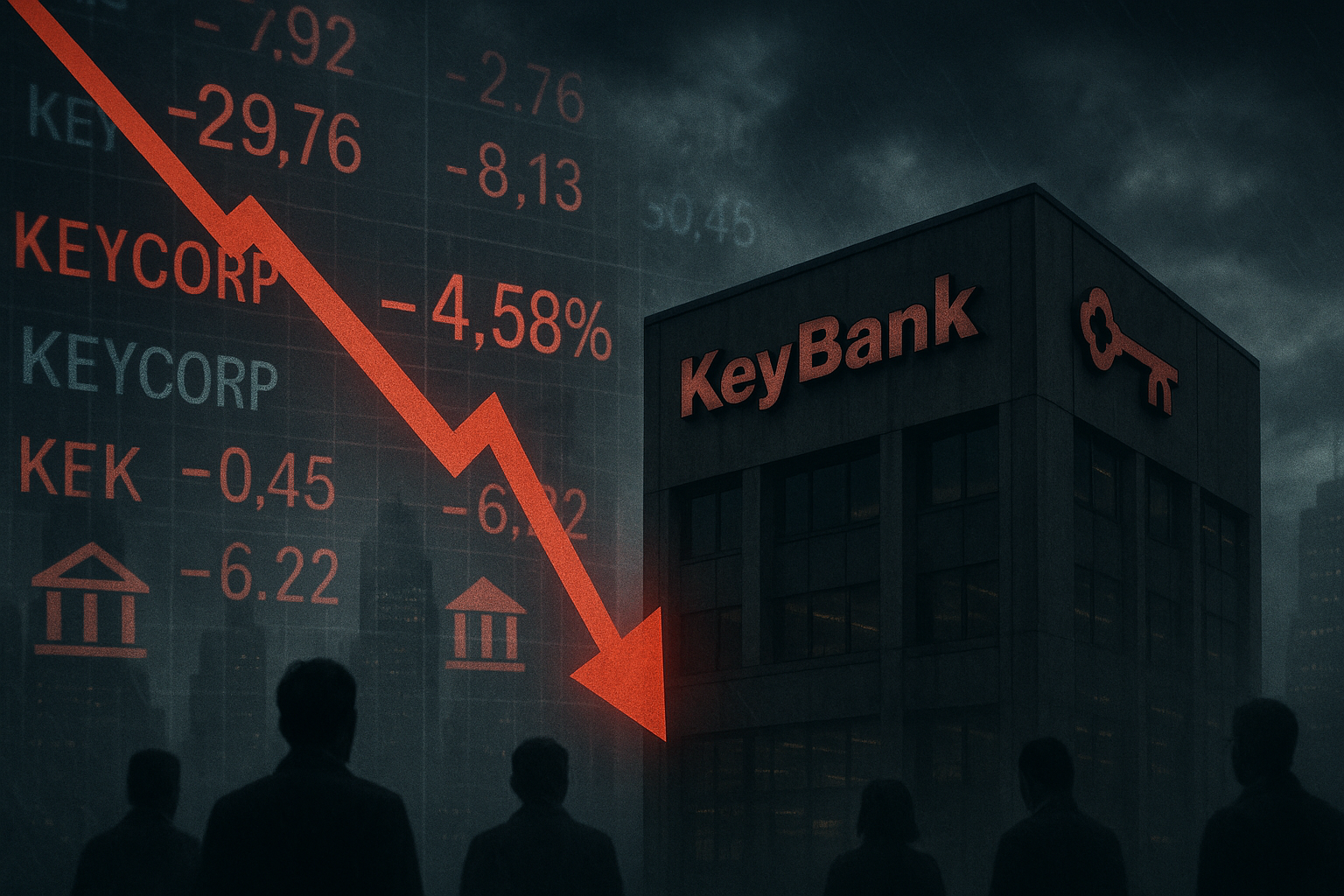
KeyCorp (NYSE: KEY) has recently experienced a notable dip in its share price, reflecting a broader retreat across the banking sector. This downturn signals a period of heightened caution among investors, as the financial industry grapples with a confluence of factors ranging from evolving interest rate expectations to shifting market sentiment. The immediate implications for KeyCorp include underperformance against both the broader market and its financial peers, alongside analyst projections for a decline in upcoming earnings and revenue, painting a challenging picture for the regional banking giant.
KeyCorp's Slide: A Symptom of Deeper Banking Sector Unease
The recent decline in KeyCorp's stock is not an isolated incident but rather a significant indicator of a wider pullback affecting the financial sector. Over recent trading periods, KeyCorp has consistently lagged behind the S&P 500 and the broader Finance sector. For instance, on a specific trading day, KeyCorp's shares fell 1.8% while the S&P 500 only saw a modest 0.32% loss. Over a month, the disparity widened, with KeyCorp shedding 3.65% compared to the Finance sector's 2.72% loss and the S&P 500's marginal 0.12% decline. This underperformance extends to longer timeframes as well; while KeyCorp's stock saw an 11.8% increase over a 52-week period, it still trailed the S&P 500's rally of over 17% and the Financial Select Sector SPDR Fund's (NYSEARCA: XLF) robust 20.2% return.
This downturn is further underscored by valuation metrics, with KeyCorp's Forward P/E ratio of 13.15 currently trading at a premium compared to its industry's average of 11.34. This suggests that despite the recent dip, the market may still be pricing in certain expectations that are not fully aligning with current performance trends or future projections. Analysts have indeed tempered their outlook, anticipating a significant decrease in KeyCorp's earnings per share (EPS) and revenue. For an upcoming earnings release, the company is projected to report EPS of $0.23, a substantial 47.73% drop from the prior year's corresponding quarter, with revenue expected to fall by 11.67% to $1.51 billion. These projections highlight the immediate financial pressures facing the bank and contribute to the cautious sentiment surrounding its stock.
The broader banking pullback is characterized by a cautious market sentiment, heavily influenced by the Federal Reserve's interest rate policy. While the Fed has maintained the target rate at 4.25% to 4.50% in 2025 and predicts two rate cuts before year-end, markets are anticipating more aggressive reductions. This divergence in expectations creates uncertainty, impacting bank profitability, particularly net interest margins. Additionally, the specter of new tariff policies has added another layer of market uncertainty, with investors particularly concerned about the economic ramifications of significantly higher tariffs on imported goods. This macro-economic backdrop, combined with specific company-level challenges, has created a challenging environment for KeyCorp and its peers.
Initial reactions from Wall Street analysts have been mixed, reflecting the complex outlook for KeyCorp. While some analysts maintain a "Moderate Buy" or "Hold" consensus, there's a clear split in sentiment. Recent actions include some analysts raising price targets, citing improved capital positions and solid quarterly results, while others have cut price targets and maintained "Hold" ratings due to factors like slightly lower investment banking fees and net interest income. This divergence underscores the uncertainty surrounding KeyCorp's near-term trajectory, with institutional investors showing bullishness through strong large-cap fund inflows, contrasting with more cautious retail investor sentiment reflected in negative small-cap flows.
The Shifting Sands: Who Wins and Who Loses in a Banking Pullback
A banking pullback, characterized by a more cautious lending environment and increased risk aversion among financial institutions, inevitably creates a distinct set of winners and losers across the financial landscape and beyond. This dynamic is particularly evident in the current climate, where regional bank vulnerabilities and broader economic uncertainties are reshaping market dynamics.
Among the clear beneficiaries are larger financial institutions, often referred to as money center banks. During periods of distress for smaller, regional players, these banking behemoths, such as JPMorgan Chase (NYSE: JPM) or Bank of America (NYSE: BAC), are well-positioned to expand their market share. They can acquire distressed regional banks at attractive valuations, thereby gaining access to new customer bases, geographic markets, and product offerings. This consolidation not only enhances their profitability but also reinforces their dominant position in the industry. Furthermore, in times of uncertainty, there's a discernible "flight to quality" as depositors and investors shift their assets from smaller, perceived-riskier institutions to larger, more established banks, bolstering their deposit base and liquidity. These larger institutions also tend to possess more robust capital buffers, making them more resilient to economic shocks and better equipped to navigate periods of reduced lending. Their active trading desks can also capitalize on increased market volatility, generating significant earnings.
Conversely, regional and mid-size banks, including KeyCorp (NYSE: KEY), often find themselves on the losing end of a banking pullback. They face intensified competition from their larger counterparts, which can lead to reduced market share and limited growth opportunities. Concerns about the stability of regional banks, especially in the wake of recent bank failures, can trigger deposit outflows, further straining their liquidity and operational capacity. These banks may also experience slowing loan growth and pressure on their profit margins, particularly if interest rate fluctuations negatively impact their net interest income. While some regional banks might become acquisition targets, those that are not absorbed into larger entities face an uphill battle for survival and sustained profitability.
Beyond the banking sector itself, non-bank lenders and private credit firms emerge as significant winners. As traditional banks tighten their lending standards and reduce credit availability, these alternative lenders step in to fill the void. Companies like Ares Management (NYSE: ARES) or Blackstone (NYSE: BX) through its credit arms, can expand their market share by providing financing to businesses and individuals who might otherwise struggle to secure loans. Their flexibility, speed, and often more innovative solutions make them attractive alternatives when traditional banks become more cautious. Similarly, Fintech companies, such as SoFi Technologies (NASDAQ: SOFI), can gain market share by offering diversified financial services and catering to digital-first consumer preferences, directly competing with established players. Companies with strong balance sheets and ample cash reserves also stand to benefit, as they are less reliant on external financing and can even seize opportunities to acquire struggling businesses at lower valuations.
On the other hand, businesses heavily reliant on bank lending, particularly small and medium-sized enterprises (SMEs), are significant losers. Tighter lending standards and reduced credit availability make it harder for these businesses to secure the financing needed for operations, expansion, or equipment, potentially hindering growth and even leading to failures. The real estate sector is also highly vulnerable, as it depends heavily on bank financing for mortgages, construction loans, and commercial property development. A pullback in lending can significantly slow down activity, depress property values, and increase defaults. Finally, consumers may face reduced choices and potentially higher fees for banking products and loans due as bank consolidation reduces competition.
Industry Impact and Broader Implications: A Ripple Effect Across the Economy
The current banking pullback, exemplified by the dip in KeyCorp (NYSE: KEY) shares, is not merely an isolated event affecting a few financial institutions; it represents a significant shift in broader industry trends with far-reaching implications for competitors, partners, and the wider economy. This cautious stance by banks, often driven by economic uncertainty, rising interest rates, and evolving regulatory landscapes, can trigger a cascade of effects that slow economic growth and reshape financial markets.
One of the most immediate and pervasive impacts is a reduction in investment and production. Businesses, particularly small and medium-sized enterprises (SMEs), are heavily reliant on bank loans for their day-to-day operations, expansion plans, and product development. When banks tighten their lending standards, the availability of credit diminishes, forcing firms to scale back on hiring, delay product launches, and slow down overall production. This can lead to a lag in economic growth and, in severe cases, contribute to increased unemployment as businesses struggle to afford their workforce. Even if credit remains available, the reduced supply of bank lending can drive up interest rates for borrowers, making it more expensive for both businesses and individuals to access funds, further dampening economic activity.
The ripple effects extend to competitors and partners within the financial ecosystem. While some competitors, particularly larger, more diversified financial institutions like JPMorgan Chase (NYSE: JPM) or Wells Fargo (NYSE: WFC), might initially benefit from a reduced lending appetite by regional banks, the overall tightening of credit conditions can eventually affect all financial institutions. Smaller banks, for instance, might see increased loan originations as larger banks pull back, but they remain susceptible to broader economic downturns. Businesses that rely on partnerships with banks for essential financial services, such as payment processing or trade finance, may experience disruptions, potentially impacting supply chains if their partners face difficulties securing financing. The impact on Fintech companies is mixed; while some thrive on the promise of "open banking" and data sharing, regulatory shifts can create uncertainty and potentially shift power dynamics back towards traditional banks, affecting innovation and market access for these agile players.
From a regulatory and policy perspective, banking pullbacks often serve as catalysts for significant responses. Historically, periods of banking distress have led to increased scrutiny and stricter regulations aimed at enhancing financial stability. Regulators may introduce new capital requirements, liquidity rules, and stress tests to prevent future crises. Conversely, there can be cycles of regulatory rollback, where policies are eased, potentially to stimulate lending or reduce compliance burdens. However, such rollbacks can have unintended consequences, such as reducing the availability of credit to certain segments or increasing systemic risk by shifting activities to less regulated non-bank entities. Central banks may also adjust monetary policy, such as lowering interest rates, to counteract the economic slowdown and encourage lending, though their effectiveness can be hampered if banks are unwilling to lend due to balance sheet impairments.
Historical precedents underscore the profound impact of banking pullbacks. The Global Financial Crisis of 2008, triggered by the subprime mortgage crisis, led to a significant dip in GDP and necessitated massive bank rescue packages globally. This crisis highlighted the interconnectedness of financial institutions and the potential for shocks to transmit domestically and internationally, leading to a sharp increase in regulation. Earlier examples, such as the 19th Century Panics and the Great Depression (1930s), also demonstrate how widespread bank failures can severely disrupt industry and commerce, contributing to recessions and depressions. These historical events consistently show that banking distress, whether systemic or non-systemic, leads to a sizable and persistent decline in output and a rise in unemployment, with the effects amplified by high corporate leverage. While each crisis has unique characteristics, the common themes of leverage, negative impact on the real economy, and the transmission of distress across the financial system remain constant.
What Comes Next: Navigating a Shifting Financial Landscape
The path forward for KeyCorp (NYSE: KEY) and the broader banking sector is characterized by a complex interplay of economic forces, technological advancements, and evolving regulatory frameworks. Both short-term and long-term possibilities present a mix of opportunities and challenges, demanding strategic pivots and continuous adaptation from financial institutions.
In the short term, KeyCorp's recent strong second-quarter 2025 results, with significant increases in net income and revenue, suggest positive momentum. The company's robust investment banking pipelines and improving credit quality, with declining net charge-offs for six consecutive quarters, are bright spots. Furthermore, KeyCorp's substantial investment of $900 million in technology for 2025, focusing on digital banking and AI, along with plans to increase frontline bankers by 10%, indicates a proactive approach to future growth and efficiency. However, challenges persist, including potential elevated deposit costs across the banking sector, which could squeeze net interest margins, and sluggish growth in consumer loans. The vulnerability of regional banks, including KeyCorp, to commercial real estate (CRE) exposure, particularly in office spaces, remains a significant concern, with prolonged inflation or a recession potentially straining these portfolios.
For the broader banking sector, the short-term outlook for 2025 is generally stable, with potential for improved net income driven by revenue growth and muted provisioning needs. The Federal Reserve's 2025 stress tests, which all regional banks passed, demonstrate the industry's resilience and could lead to reduced capital requirements, potentially freeing up capital for share buybacks and dividend growth. A more favorable interest rate environment for regional banks, as they restructure their balance sheets to capitalize on steeper yield curves, could also boost net interest margins. Increased merger and acquisition (M&A) activity, especially among regional banks seeking operational scale, is also a strong possibility. However, decelerating U.S. GDP growth, persistent elevated deposit costs, and a normalization of credit quality with modest increases in delinquencies, particularly in credit card and auto loans, pose headwinds.
Looking to the long term, the banking sector is poised for a profound transformation driven by digitalization and AI integration. AI is expected to reshape banking operations, enhancing efficiency, improving risk management, and enabling hyper-personalized services. AI-powered automation can streamline processes, detect fraud, and provide deeper insights into client behavior, potentially saving banks millions in operational costs. This will facilitate a shift from product-centric to customer-centric models, offering tailored financial experiences. The adoption of open-source architectures like Linux is also anticipated to form the backbone of banking infrastructure by 2030, enabling greater agility and security. The rise of embedded finance and Banking-as-a-Service will further integrate financial services into non-financial platforms, opening new avenues for product delivery. However, long-term challenges include intensified competition from digital-only banks (neobanks) and non-traditional players, the continuous evolution of regulatory frameworks around data privacy, cybersecurity, and AI, and the ethical and legal concerns associated with AI, such as algorithmic bias and lack of transparency.
To navigate these evolving dynamics, both KeyCorp and the broader banking sector must implement critical strategic pivots. Accelerated digital transformation, with heavy investment in AI, cloud computing, and data analytics, is paramount for efficiency and enhanced customer experiences. Strengthening risk management frameworks, particularly concerning commercial real estate exposure and cybersecurity threats, is crucial. Diversifying revenue streams by focusing on non-interest income, such as investment banking and wealth management, will be vital as net interest income may face pressure. A shift to customer-centric strategies, leveraging data and AI for personalized offerings, will be key to retaining and attracting customers. Proactive regulatory compliance and strategic partnerships with fintechs will also be essential for innovation and growth. The potential scenarios range from a favorable economic soft landing with gradual rate cuts, leading to continued growth and M&A opportunities, to persistent inflation and higher-for-longer interest rates, which would strain net interest margins and credit quality. Accelerated digital disruption and increased regulatory scrutiny also present distinct challenges that require rapid adaptation and robust compliance.
Conclusion: A Pivotal Moment for the Banking Industry
The recent dip in KeyCorp (NYSE: KEY) shares, set against the backdrop of a broader banking pullback, marks a pivotal moment for the financial industry. The key takeaway is that the banking sector is undergoing a significant transformation, driven by macroeconomic shifts, technological advancements, and evolving regulatory expectations. While KeyCorp has demonstrated resilience and strategic foresight through its investments in technology and expansion of frontline staff, the industry as a whole faces a complex and uncertain future.
Moving forward, the market will closely watch several critical indicators. For KeyCorp, investor attention will be on its ability to sustain revenue growth, particularly in non-interest income areas like investment banking, and its success in managing deposit costs and commercial real estate exposure. The effectiveness of its substantial technology investments in driving efficiency and enhancing customer engagement will also be a key determinant of its long-term performance.
For the broader banking sector, the trajectory of interest rates and the Federal Reserve's monetary policy will remain paramount, influencing net interest margins and overall profitability. The pace of economic growth and consumer spending will dictate loan demand and credit quality. Furthermore, the regulatory landscape, particularly any shifts towards deregulation or increased scrutiny in areas like AI governance and data privacy, will significantly shape operational frameworks and compliance costs. The competitive intensity from digital-only banks and fintechs will also continue to challenge traditional banking models, pushing incumbents to innovate at an accelerated pace.
In the coming months, investors should closely monitor earnings reports from regional banks for insights into credit quality trends and net interest margin performance. Any signs of increased M&A activity could signal consolidation and a reshaping of the competitive landscape. Ultimately, the banks that successfully embrace digital transformation, strategically manage risk, diversify their revenue streams, and prioritize customer-centricity will be best positioned to thrive in this evolving financial environment, while those that fail to adapt may face significant headwinds and potential market share erosion. The current pullback is not just a temporary blip but a clear signal of a new era for banking, demanding agility, foresight, and a relentless focus on innovation.






